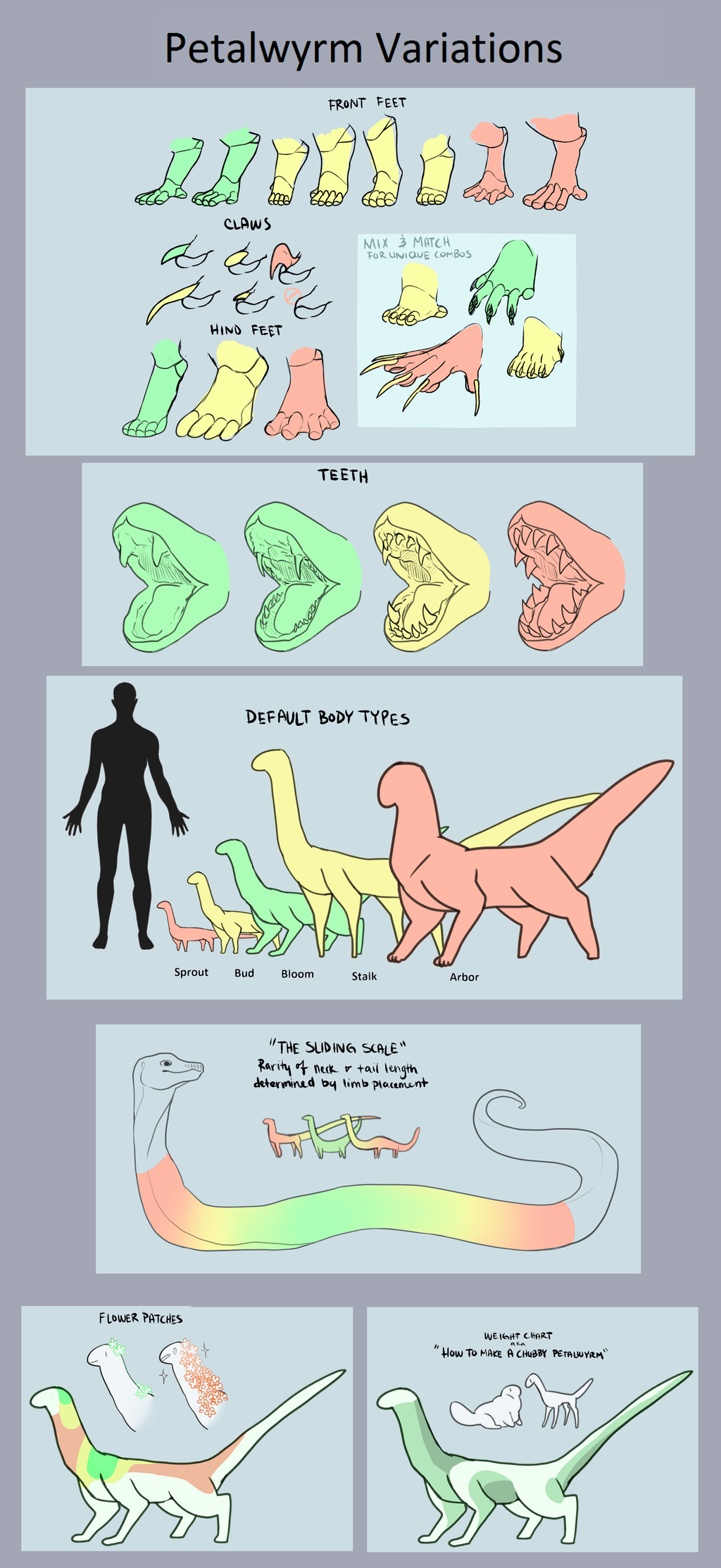HOME | DD
 WearyWere — [OUTDATED!] Petalwyrm Variations Chart
WearyWere — [OUTDATED!] Petalwyrm Variations Chart

#chart #original #species #petalwyrm #petalwyrms
Published: 2015-12-17 05:39:59 +0000 UTC; Views: 2106; Favourites: 27; Downloads: 5
Redirect to original
Description
Some more info on what the charts mean:


Feet:
Petalwyrms have all sorts of different feet and variations in paw types, shapes, sizes and claws are not uncommon, though which types a Petalwyrm has vary in rarity.
When deciding which feet and claws to pick for your Petalwyrm, remember that if you have access to an uncommon or rare set, that you will be able to pick any choices from the access level you have and below.
Also, whichever you choose will affect your Petalwyrm's behaviors:
Petalwyrms with sharp claws will be prone to more neatly pruned gardens.
Petalwyrms with no claws will lend more to being slightly omnivorous due to their methods of pruning their gardens with their teeth and their gradual inclination to chew on their plants.
Petalwyrms with webbed feet will not be as willing to go far from bodies of water and will more likely prefer waterside or swamp plants.
Teeth:
All Petalwyrms eat some form of meat and all have teeth and jaw of carnivores, even if they develop omnivorous tendencies. Their teeth do not always determine what they eat, prey wise, but they may dictate size.
Commonly, Petalwyrms have more snake-like teeth, with fangs and the occasional row of small teeth. These kinds of Petalwyrms will mostly go after prey that is smaller than them, though if they are brave or have more venomous qualities, they may go for larger prey.
Less often, a Petalwyrm may have larger, sharper teeth. These often will need to go after larger prey and will aim for prey that is at least their size.
Petalwyrms with venom must have fangs, but their teeth may vary in size all the same. Petalwyrms without venom can be anything from constrictors to those who rely on more violent, mauling kills.
Body Types:
Petalwyrms come in a variety of sizes, from petite to massive. The chart above is compared to a 6 foot tall human being. Each one can be adjusted in regards to weight and amount of fat, but their builds are typically centered around these five types.
Sprouts typically have shorter legs and thinner proportions, and are less prone to muscle growth due to their runt like size.
Buds are like smaller versions of Blooms and are typically more agile than their larger counterparts.
Blooms are the most average of all the body types in regards to height and muscle mass and make up the majority of the population.
Stalks are the tallest of the types and are relatively durable despite how little muscle they build in regards to their counterparts, the Arbors.
Arbors are the strongest and bulkiest of the types, less agile than the others but much stronger.
The Sliding Scale:
You have to think about Petalwyrms like snakes. When it comes down to deciding how long their neck or tails are, it is helpful to remember this fact since the placement of their limbs along the "snake's body" determines both.
Most have their legs in the middle, making their necks and tails about even in length.
Some have shorter necks and longer tails, others have shorter tails and longer necks. How much they differ in length determines rarity as most Petalwyrms are relatively balanced in neck and tail lengths.
Flower Patches:
Petalwyrms have adhesive scales along their necks and backs, but the areas that are adhesive differ in size between Petalwyrms. These spots are where they arrange their flowers and they do not differ in appearance to the rest of their scales. These spots are extremely sticky and the only way to make sure everything is detached is to soak their scales, which will ruin their bouquets. This is why they hate getting anything other than their flowers, from dirt to twigs, near their patches.
Most have small spots along the tops of their necks and the base of their necks where they arrange their flowers. Petalwyrms with patches this small are the most likely to venture out of their gardens and go into places that provide a higher chance of picking up debris.
Petalwyrms with larger patches are more likely to be cleanly, but there are some that don't care much about their flowers as much and will end up with messy bouquets to show for their adventurous natures.
Weight:
Petalwyrms can get very chubby or can be very thin. This chart shows where they are more likely to gain weight and store fat, though there is nothing akin to rarity concerning weight. Any Petalwyrm can be fat or as thin as a rail, though you should take their body type into consideration when you're deciding their chubbiness, as this chart is based off of the Bloom body type.
Reminder: Blooms and Buds have the largest weight variations. Sprouts and Stalks are prone to be thinner, but can gain quite a bit of weight if you so choose. Arbors can be chunky but do not tend to be as thin.
--
Please leave a comment if you have any questions or further inquiries about the species, and I will be happy to help.
Related content
Comments: 6

AAANANNANANAADDDD I changed all my Petalwyrms....
👍: 0 ⏩: 0

I may change my petalwyrm to have the "stalk" body type. So fluid.
👍: 0 ⏩: 1

Go ahead! I'm quite fond of Stalks myself aha
👍: 0 ⏩: 1


























